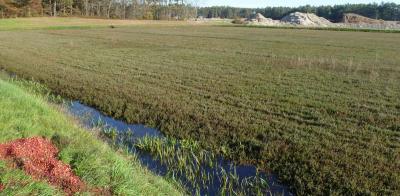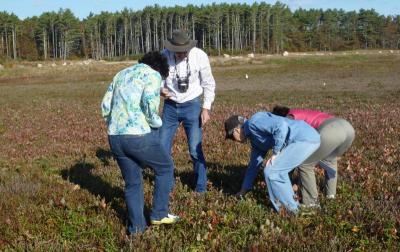Land Trust bog tour highlights cranberry industry
The area may be known for those little red berries, but what do we know about them?
The Rochester Land Trust held a cranberry bog walking tour around resident Doug Beaton’s property off Mary’s Pond Road on Sunday to answer those questions. Cranberry farmer and Rochester resident Kirby Gilmore narrated guests through a short history of the industry and explained the numerous techniques and work involved with growing the plants.
Beaton’s 400-plus acres of bogs, across from Leonard’s Pond, is full of history. Originally built in the 1920s, the area now is under a conservation restriction held by the Coalition for Buzzards Bay and the Land Trust.
Land Trust Board member Norene Hartley said cranberry farmers and bogs are important for the area.
“The open space around cranberry bogs provides habitat for insects that pollinate cranberries,” Hartley said. “And the open space is essential for growers to maintain their crops and for the wildlife around us. Cranberry growers are very good stewards of the land.”
Gilmore said years of industry improvements have greatly increased cranberry production.
“When the bogs were first built, the farmers would gather 20 to 30 barrels an acre,” Gilmore said. “A barrel is 100 pounds of cranberries. Now we expect to get nearly 200 barrels per acre.”
Gilmore belongs to the Ocean Spray agriculture cooperative, and his bogs in Carver are used in the filming of the company’s quirky commercials.
The constant weather checking, battling of pests and maintaining the bogs always keep farmers busy. Continual flooding and the wintertime practice of spreading sand over frozen bogs are just some of the ways farmers naturally keep their crop healthy.
“We’ll put sand on the bogs for several reasons,” Gilmore said. “In the old days they didn’t have fertilizer, but they found that sand promoted vine growth. And one of the insects we have is indigenous to the bogs. If you cover the pupae with sand, they can’t survive.”
Despite the improvements in farming, Gilmore said tough times are still ahead. He said cranberry crops can earn from $10 to $65 a barrel, but it usually costs about $35 per barrel to grow the crop. Tack that onto the $35,0000 to $50,000 spent on replanting just one acre. If a bog isn’t maintained properly an entire replanting could occur. Gilmore added that it takes four or five years for a replanted bog to come to fruition, and that the time and money required to keep up and harvest the bog in today’s economy could hurt the industry.
“Cranberries are really the only viable agriculture for this county,” Gilmore said, noting that the area once had prominent dairy and poultry businesses in the past. “But I think that maybe they’ll go out, which is unfortunate.”
However, many of those walking the tour enjoyed being out and getting a chance to actually be on a bog.
Rochester Land Trust president Halima Tiffany said her favorite part was simply learning the ins and outs of the cranberry business.
“I loved learning about cranberries and everything that goes into it,” she said. “We have them all around us, but I never knew what went into them!
















